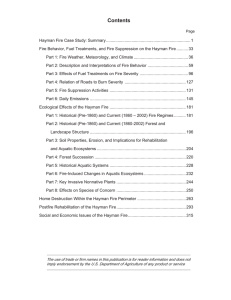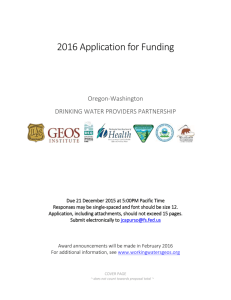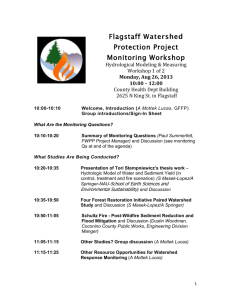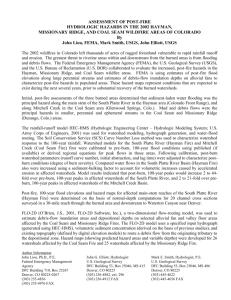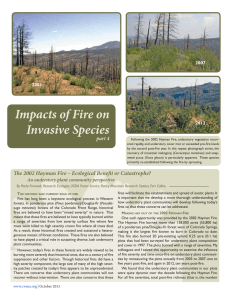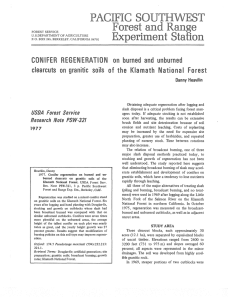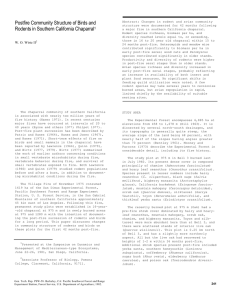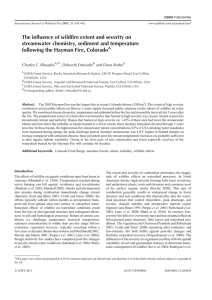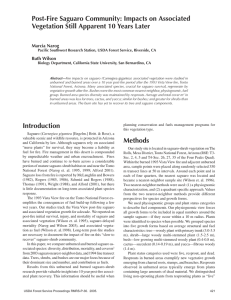Targeting Post-Wildfire Watershed Restoration at Source Water Protection C L
advertisement
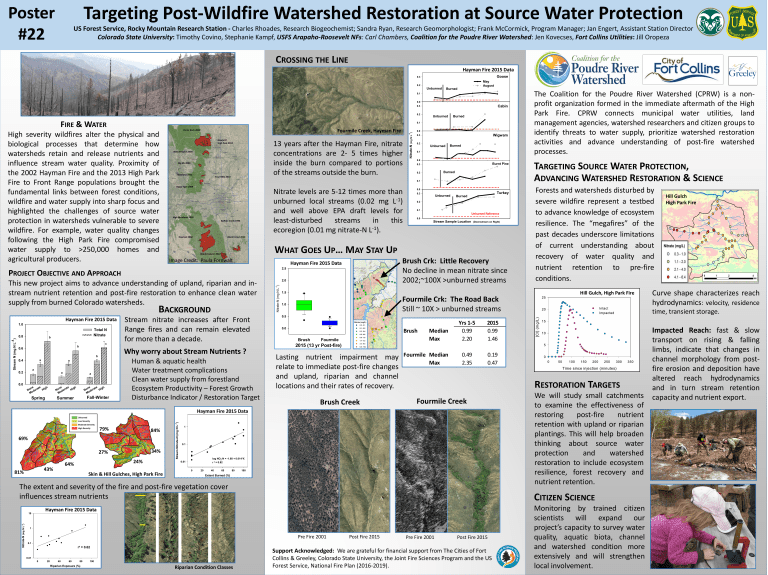
Targeting Post-Wildfire Watershed Restoration at Source Water Protection Poster #22 US Forest Service, Rocky Mountain Research Station - Charles Rhoades, Research Biogeochemist; Sandra Ryan, Research Geomorphologist; Frank McCormick, Program Manager; Jan Engert, Assistant Station Director Colorado State University: Timothy Covino, Stephanie Kampf, USFS Arapaho-Roosevelt NFs: Carl Chambers, Coalition for the Poudre River Watershed: Jen Kovecses, Fort Collins Utilities: Jill Oropeza CROSSING THE LINE Hayman Fire 2015 Data Goose 0.3 May August 0.2 Unburned Burned 0.1 0.0 Cabin 0.3 0.2 FIRE & WATER Fourmile Creek, Hayman Fire Picnic Rock 2004 Hewlett/ High Park 2012 13 years after the Hayman Fire, nitrate concentrations are 2- 5 times higher inside the burn compared to portions of the streams outside the burn. Bobcat Gulch 2000 Big Elk 2000 Overland 2003 Four Mile 2010 Black Tiger 1989 Nitrate levels are 5-12 times more than unburned local streams (0.02 mg L-1) and well above EPA draft levels for least-disturbed streams in this ecoregion (0.01 mg nitrate-N L-1). High Meadows 2000 Buffalo Creek 1996 Hayman 2002 Stream N (mg N L-1) b c b 0.6 Image Credit: Paula Fornwalt Hayman Fire 2015 Data 2.5 a 0.4 a a 0.2 a a 0.0 ne ate igh H No der o M ne ate igh H No der o M Spring Summer Stream nitrate increases after Front Range fires and can remain elevated for more than a decade. Why worry about Stream Nutrients ? b ne ate igh H No der o M Fall-Winter 0.2 Unburned Burned 0.1 0.0 Burnt Pine 0.3 Burned 0.2 0.0 0.3 Unburned Turkey Burned 0.2 0.1 Unburned Reference 0.0 Stream Sample Location (Downstream on Right) WHAT GOES UP… MAY STAY UP Waldo Canyon 2012 Human & aquatic health Water treatment complications Clean water supply from forestland Ecosystem Productivity – Forest Growth Disturbance Indicator / Restoration Target 2.0 #22 -1 Nitrate-N (mg N L ) BACKGROUND 0.8 Wigwam 0.3 Black Forest 2013 This new project aims to advance understanding of upland, riparian and instream nutrient retention and post-fire restoration to enhance clean water supply from burned Colorado watersheds. Total N Nitrate 0.0 0.1 PROJECT OBJECTIVE AND APPROACH 1.0 Nitrate-N (mg N L-1) 0.1 High severity wildfires alter the physical and biological processes that determine how watersheds retain and release nutrients and influence stream water quality. Proximity of the 2002 Hayman Fire and the 2013 High Park Fire to Front Range populations brought the fundamental links between forest conditions, wildfire and water supply into sharp focus and highlighted the challenges of source water protection in watersheds vulnerable to severe wildfire. For example, water quality changes following the High Park Fire compromised water supply to >250,000 homes and agricultural producers. Hayman Fire 2015 Data Burned Unburned 1.5 1.0 Brush Crk: Little Recovery No decline in mean nitrate since 2002;~100X >unburned streams Fourmile Crk: The Road Back Still ~ 10X > unburned streams 0.0 Brush Brush Fourmile Median Max Yrs 1-5 0.99 2.20 2015 0.99 1.46 69% 34% 27% 43% 81% 24% 64% Lasting nutrient impairment may relate to immediate post-fire changes and upland, riparian and channel locations and their rates of recovery. Brush Creek Fourmile Median Max 0.49 2.35 0.19 0.47 Fourmile Creek Skin & Hill Gulches, High Park Fire 0.1 log NO3-N = -1.68 + 0.014*X r ² = 0.82 0 20 40 60 80 100 Extent Burned (%) The extent and severity of the fire and post-fire vegetation cover influences stream nutrients Nitrate-N (mg N L-1) 1 Pre Fire 2001 Post Fire 2015 Pre Fire 2001 Post Fire 2015 0.1 r² = 0.62 0.01 0 20 40 60 80 Riparian Exposure (%) 100 Riparian Condition Classes Support Acknowledged: We are grateful for financial support from The Cities of Fort Collins & Greeley, Colorado State University, the Joint Fire Sciences Program and the US Forest Service, National Fire Plan (2016-2019). Hill Gulch High Park Fire Curve shape characterizes reach hydrodynamics: velocity, residence time, transient storage. We will study small catchments to examine the effectiveness of restoring post-fire nutrient retention with upland or riparian plantings. This will help broaden thinking about source water protection and watershed restoration to include ecosystem resilience, forest recovery and nutrient retention. CITIZEN SCIENCE Hayman Fire 2015 Data 10 Hill Gulch, High Park Fire RESTORATION TARGETS 1 0.01 Forests and watersheds disturbed by severe wildfire represent a testbed to advance knowledge of ecosystem resilience. The “megafires” of the past decades underscore limitations of current understanding about recovery of water quality and nutrient retention to pre-fire conditions. 2015 (13 yr Post-fire) -1 Stream Nitrate-N (mg N L ) 84% TARGETING SOURCE WATER PROTECTION, ADVANCING WATERSHED RESTORATION & SCIENCE 0.5 Hayman Fire 2015 Data 79% The Coalition for the Poudre River Watershed (CPRW) is a nonprofit organization formed in the immediate aftermath of the High Park Fire. CPRW connects municipal water utilities, land management agencies, watershed researchers and citizen groups to identify threats to water supply, prioritize watershed restoration activities and advance understanding of post-fire watershed processes. Monitoring by trained citizen scientists will expand our project’s capacity to survey water quality, aquatic biota, channel and watershed condition more extensively and will strengthen local involvement. Impacted Reach: fast & slow transport on rising & falling limbs, indicate that changes in channel morphology from postfire erosion and deposition have altered reach hydrodynamics and in turn stream retention capacity and nutrient export.
